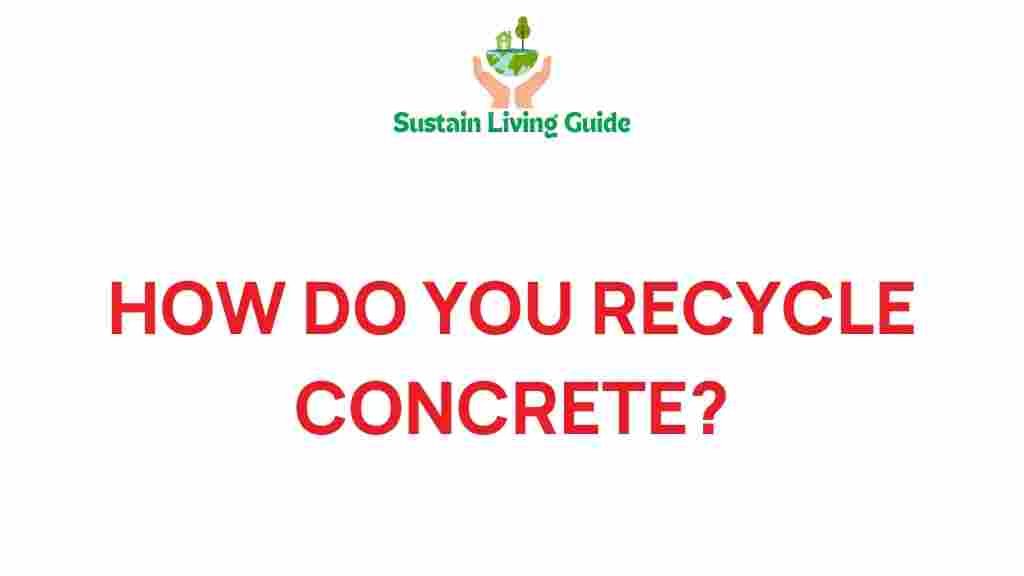Concrete Recycling: The Path to Sustainability
Concrete recycling is an essential process in today’s construction industry, paving the way for sustainable building practices. As the world grapples with environmental challenges, the need for eco-friendly solutions has never been more pressing. This article delves into the secrets of concrete recycling, exploring its benefits, processes, challenges, and the future it promises.
Understanding Concrete Recycling
Concrete recycling involves the reprocessing of old concrete into new construction materials. Rather than disposing of concrete waste in landfills, recycling allows it to be reused, significantly reducing environmental impact. Here are the primary reasons why concrete recycling is vital:
- Environmental Benefits: Reduces landfill waste and conserves natural resources.
- Cost-Effective: Saves money on disposal and procurement of new materials.
- Energy Efficient: Less energy is required to recycle concrete compared to producing new materials.
The Process of Concrete Recycling
Concrete recycling is not just about collecting and reusing old concrete; it involves a systematic approach. Here’s a step-by-step breakdown of the recycling process:
1. Collection and Transportation
The first step in concrete recycling is the collection of concrete debris from construction sites, demolition projects, or other sources. This debris is then transported to a recycling facility.
2. Crushing and Screening
Once at the recycling facility, the concrete is crushed into smaller pieces using specialized machinery. The crushed concrete is then screened to separate fine materials from larger chunks.
3. Removal of Contaminants
It’s crucial to remove contaminants such as metal, wood, and plastics to ensure the quality of the recycled material. This is usually done using magnets and air separators.
4. Quality Control
The recycled concrete is then subjected to quality control tests to ensure it meets industry standards for reuse. This step is vital to maintain the integrity of the final product.
5. Reuse in New Projects
Finally, the processed recycled concrete can be reused in various construction applications, including:
- New concrete mixes
- Road base materials
- Landscaping and drainage systems
Benefits of Concrete Recycling
Concrete recycling offers numerous benefits that make it an attractive option for construction companies:
- Reduction in Landfill Waste: Recycling concrete diverts a significant amount of waste from landfills, helping to alleviate the burden on waste management systems.
- Resource Conservation: It conserves natural resources by reducing the need for new aggregates, which are often mined at a high environmental cost.
- Economic Savings: Companies can save on disposal fees and reduce material costs, leading to a more profitable project.
- Lower Carbon Footprint: Recycling concrete requires less energy compared to the production of new materials, thus reducing greenhouse gas emissions.
Challenges in Concrete Recycling
Despite its many advantages, concrete recycling also faces challenges that need to be addressed:
- Quality Concerns: Ensuring the recycled concrete meets industry standards can be a challenge, particularly with contaminants present.
- Cost of Equipment: The initial investment in recycling equipment can be high, deterring some companies from adopting recycling practices.
- Market Demand: The demand for recycled concrete can fluctuate, affecting its viability as a sustainable option.
Internal and External Resources
For further information on concrete recycling and its benefits, you can check out this resource which provides detailed insights into sustainable construction practices. Additionally, for a broader understanding of recycling, visit this external link to learn more about various recycling methods.
Common Troubleshooting Tips
When engaging in concrete recycling, there may be challenges that arise. Here are some troubleshooting tips to help ensure a smooth process:
- Contaminants: Always conduct a thorough inspection of the raw materials. Remove any non-concrete elements before processing.
- Machinery Failure: Regular maintenance and inspections of crushing and screening equipment can prevent downtime.
- Quality Issues: Implement stringent quality control measures throughout the recycling process to ensure compliance with industry standards.
The Future of Concrete Recycling
The future of concrete recycling looks promising, driven by technological advancements and growing environmental awareness. Here are some trends to watch:
- Innovative Technologies: New technologies are being developed to enhance the efficiency and effectiveness of recycling processes, such as automated sorting systems.
- Legislation and Incentives: Governments may introduce stricter regulations on waste disposal and provide incentives for companies that adopt sustainable practices.
- Increased Awareness: As more construction companies recognize the benefits of concrete recycling, its adoption is likely to rise.
Conclusion
Concrete recycling is more than just a trend; it is a sustainable revolution that offers significant advantages for the environment, economy, and construction industry. By embracing concrete recycling, we can reduce waste, conserve resources, and contribute to a greener future. As we uncover the secrets of this process, it becomes clear that concrete recycling is not just beneficial—it is essential for sustainable development.
Incorporating concrete recycling into your construction practices can lead to immense benefits. Whether you are a contractor, builder, or property owner, understanding and utilizing recycled concrete is a step towards a more sustainable and responsible construction industry.
This article is in the category Waste and created by SustainLivingGuide Team
